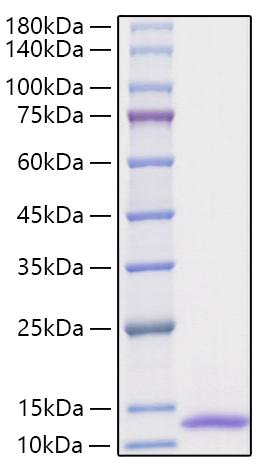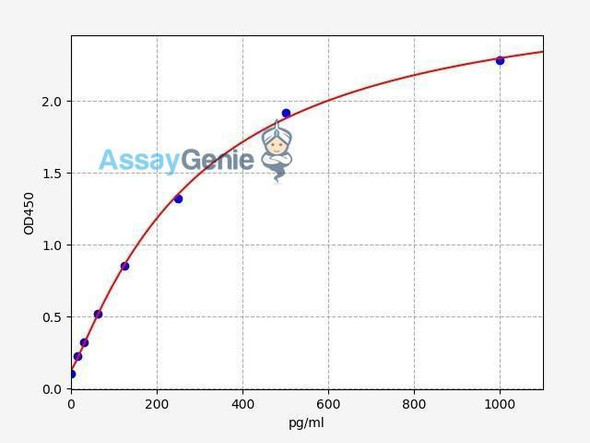Description
Recombinant Human CXCL1/GRO-alpha Protein
The Recombinant Human CXCL1/GRO-alpha Protein is a biologically active recombinant protein that plays a significant role in various cellular processes and signaling pathways in human biology. This protein is widely employed in immunological research, cell biology studies, protein-protein interaction analyses, and therapeutic development, providing researchers with a reliable tool for investigating CXCL1/GRO-alpha function and its implications in health and disease.
This product (SKU: RPCB1225) is produced using advanced expression systems and features a No-tag tag for convenient detection and purification. The protein exhibits a calculated molecular weight of 7.86 kDa with an observed molecular weight of 10-15 kDa under denaturing conditions, achieving ≥ 95% as determined by SDS-PAGE., ensuring exceptional quality and consistency for research applications.
Key Features
| High Purity by Affinity Chromatography | |
| Mammalian & Bacterial Expression Systems | |
| High lot-to-lot consistency via strict QC |
| Product Name: | Recombinant Human CXCL1/GRO-alpha Protein |
| SKU: | RPCB1225 |
| Size: | 10 μg , 20 μg , 50 μg , 100 μg |
| Reactivity: | Human |
| Synonyms: | CXCL1, GRO, GRO1, GROA, MGSA, SCYB1, Growth-regulated alpha protein, C-X-C motif chemokine 1, GRO-alpha(1-73), Melanoma growth stimulatory activity, MGSA, Neutrophil-activating protein 3, NAP-3, Cleaved into: GRO-alpha(4-73), GRO-alpha(5-73), GRO-alpha(6-73) |
| Tag: | No-tag |
| Calculated MW: | 7.86 kDa |
| Observed MW: | 10-15 kDa |
| Gene ID: | 2919 |
| Protein Description: | High quality, high purity and low endotoxin recombinant Recombinant Human CXCL1/GRO-alpha Protein (RPCB1225), tested reactivity in E. coli and has been validated in SDS-PAGE.100% guaranteed. |
| Endotoxin: | < 0.1 EU/μg of the protein by LAL method. |
| Purity: | ≥ 95% as determined by SDS-PAGE. |
| Formulation: | Lyophilized from a 0.22 μm filtered solution of PBS, pH 7.4. |
| Reconstitution: | Centrifuge the vial before opening. Reconstitute to a concentration of 0.1-0.5 mg/mL in sterile distilled water. Avoid vortex or vigorously pipetting the protein. For long term storage, it is recommended to add a carrier protein or stablizer (e.g. 0.1% BSA, 5% HSA, 10% FBS or 5% Trehalose), and aliquot the reconstituted protein solution to minimize free-thaw cycles. |
| Storage: | Store at -20℃.Store the lyophilized protein at -20℃ to -80 ℃ up to 1 year from the date of receipt. After reconstitution, the protein solution is stable at -20℃ for 3 months, at 2-8℃ for up to 1 week. |
CXCL1, also known as GRO-α, is a polypeptide that is initially isolated from human melanoma cells. CXCL1 acts as a key chemoattractant for neutrophils by binding specifically to its corresponding G-protein-coupled receptor CXCR2. CXCL1 modulates angiogenesis, tumorigenesis, and wound healing. In general, CXCL1 levels are extremely low under normal physiological conditions and greatly increased during inflammatory conditions.The amino acid sequence of human CXCL1 protein has low homology between mouse and rat CXCL1 protein. After translation, the synthesized CXCL1 precursor is 107aa long. A signal peptide is removed from its N-terminus, which shortens the precursor to 73aa. Two other amino acids can also be removed from the C-terminus. In addition, two disulfide bridges are formed from all four cysteine residues in CXCL1. The disulfide bridges give the appropriate structure to CXCL1, which determines the properties of this chemokine. After secretion, CXCL1 undergoes further proteolytic processing, which regulates the activity of this chemokine. From the N-terminus, three, four or five amino acids are removed, which produce CXCL1(4-73), CXCL1(5-73), and CXCL1(6-73), respectively. This increases CXCL1 activity 30 times, as measured by its ability to induce the chemotaxis of treated cells. To date, three CXCL1 receptors have been discovered-CXCR1, CXCR2 and atypical chemokine receptor 1 (ACKR1). Through NF-κB activation, CXCL1 expression is increased by cytokines such as IL-1β, TNF-α and IL-17. CXCL1 can associate into bioactive dimers and primarily signals through CXCR2/IL-8 RB. After CXCL1 expression is induced by carcinogens, it participates in inflammatory responses by recruiting neutrophils. This leads to chronic inflammation. In addition to increasing proliferation, CXCL1 also induces cancer cell migration, particularly EMT. Produced by lymphatic endothelial cells (LECs), CXCL1 enables tumor cell migration into the lymphatic vessels during lymphangiogenesis, leading to lymph node metastasis. CXCL1 is a chemotactic factor for neutrophils. Additionally, it causes the mobilization of these cells from the bone marrow. CXCL1 can also induce recruitment of regulatory T cells (Treg) and MSCs into the tumor niche. Another no-less-important property of CXCL1 is its ability to induce angiogenesis.







